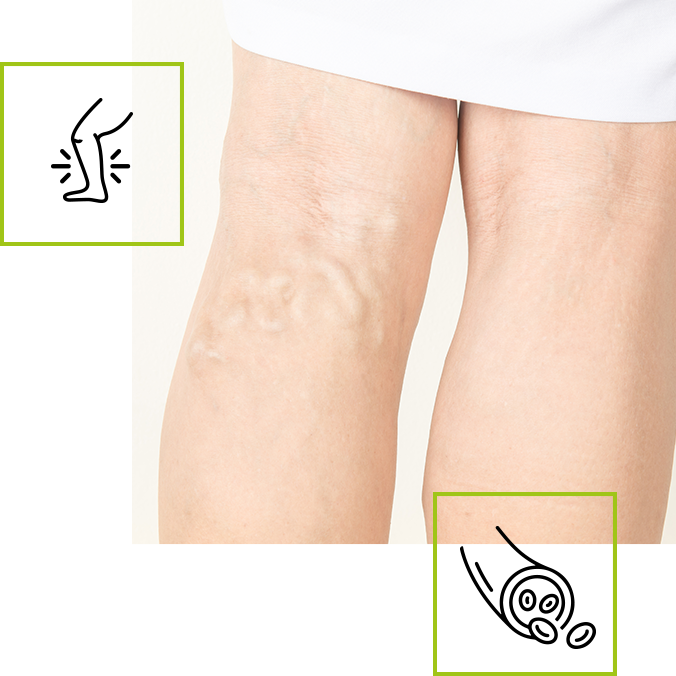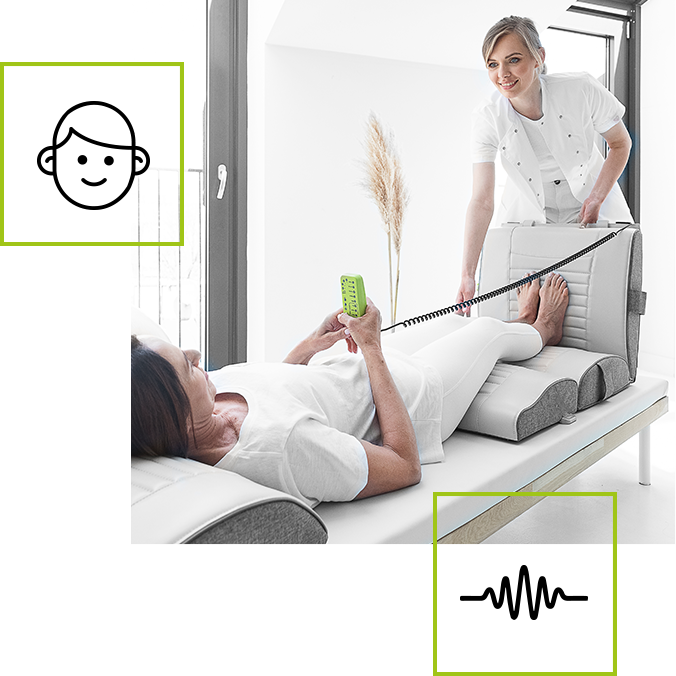Vibrotherapy – an effective method to combat leg pain
Vibrotherapy helps combat pain in combination with or in preparation for other therapies, but in many cases it also works beneficially on its own as a sole therapy.
How does it work?
Vibrotherapy eliminates or relieves leg pain through several mechanisms. It stimulates both superficial and deeply localized pain receptors, raising the pain threshold for a long time, resulting in less pain.
In addition, it improves blood circulation – it affects the dilation of blood vessels, regulating blood pressure, and improves lymph circulation.
Promotes relief of inflammation; improves bone mineral density; relaxes and strengthens muscles.


When and for whom?
Vibrotherapy can be successfully used by people suffering from leg pain of various causes. Of course, medical management should be consulted with a doctor, especially for more severe diseases. Vibrotherapy treatments benefit people suffering from varicose veins and swelling of the limbs, and it is also a great type of prevention of venous disease. In addition, vibrotherapy can be used to relieve pain resulting from excessive muscle tension and as a form of rehabilitation after injury. The effect of vibrotherapy on muscles will be appreciated by people who do standing or sitting work.
Effectiveness
Studies show that chronic leg pain subsides or is significantly relieved after several weeks or so of properly parameterized vibration therapy.

Grubbs BF, Figueroa A, Kim JS, Contreras RJ, Schmitt K, Panton LB. Whole-body Vibration Training in Frail, Skilled Nursing Home Residents. Int J Exerc Sci. 2020 Feb 1;13(3):140-156
Benefits of vibrotherapy

No side effects

Action confirmed by scientists and practitioners

Perceptible effects from 1 treatment

Long-lasting effects through systematic use
Choose the right product
We will help you select a set of modules that suits your conditions.
Sharp leg pain
A sharp, penetrating pain in the legs, radiating from the calf to the thighs, may accompany diseases of the musculoskeletal system, the nervous system or the vascular system. While we can recognize a knee joint problem quite easily, the connection between spinal changes and leg pain is not so intuitive. Very often it is the pressure on the nerves in the lumbar region that is the cause of radiating, sharp pain throughout the legs (from thigh to foot). It results from compression of the sciatic nerve, consisting of the spinal nerves L4, L5 and S1. This type of pain occurs with sciatica, femoral sciatica, but can also result from arthritis, especially of the sacroiliac joint. If the sharp leg pain occurs while walking and subsides after resting for a while, it may have a vascular basis: a peripheral circulation disorder caused by narrowing and obstruction of the arteries. This condition is referred to as intermittent claudication. If, on the other hand, a sharp leg pain occurs along with a feeling of coldness in the limb, it is usually indicative of ischemia. These types of symptoms can be linked to atherosclerosis, so see a doctor immediately.
Pain in the legs below the knee, feeling of “leg heaviness”
Leg pain below the knee is very often combined with varicose veins. Is this really the most common cause? If we have not experienced previous trauma, the pain is not muscle overload (for example, after strenuous training, physical activity to which we are not accustomed), then there is a good chance that it may be due to pathological changes in the veins. This type of pain at first may appear after standing for a long time or adopting a position that impedes blood circulation (putting leg over leg, sitting on a contracted leg). If you notice such symptoms in yourself, it is worth introducing prevention as soon as possible: physical activity, treatments that promote blood circulation and eliminate factors that can negatively affect the condition of the veins (improper diet, smoking, drinking alcohol). This is because over time, venous thrombosis, a serious disease, can develop. Leg pain accompanying thrombosis is most often combined with a "spreading" feeling, swelling, increased muscle tension, and less often with bruising and redness. It requires medical consultation as soon as possible. However, leg pain below the knee is not always related to blood vessels. Sometimes its cause is quite trivial and easy to treat, and it is a deficiency of certain elements, especially magnesium, potassium and calcium. In such cases, calf pain is often accompanied by painful cramps.
Changes in calf muscle structure
Caused by prolonged wearing of high-heeled shoes - this point is also related to footwear, but it is so important that we decided to separate it, because leg pain (calves, especially along the tibia) occurs in women when they change their habits and choose shoes with flat soles instead of high heels. Suddenly you find that your feet don’t hurt when walking in shoes that are advised against by doctors, but they hurt when you put on the correct footwear. This is due to the changes that have taken place in the muscles. According to scientific studies, long-term wearing of high-heeled shoes shortens muscle fibres by 13%. It also stiffens the Achilles tendon. In this situation, you should give up high heels - gradually.
Muscle overload
They affect not only athletes, but also people who do standing or sitting jobs. In this situation, prevention is key - taking physical activity that is tailored to one’s abilities, taking care of one's diet, and taking short breaks at work to “stretch” the muscles.
Leg pain along the tibia
Appears on the outside of the calves and usually hurts along the tibia. In this case, the underlying cause of the pain may also be related to the vascular system (or more specifically, changes in the veins).
Walking in mismatched and uncomfortable footwear
This is especially true of wearing high-heeled shoes, which negatively affect the Achilles tendon (over time they can even cause structural changes in the tendon), and footwear that does not properly support the foot and forces an unnatural gait - flip-flops are on the podiatrists’ “black list”.
Degenerative changes of the spine and leg pain
The pain radiates from the spine to the calf, and if it manifests only along the tibia (not pain in the inner part of the calf), the pressure is on the L5 and S1 spinal nerve. Often, however, degenerative changes affect the entire lumbar nerve plexus (known as the sciatic nerve).It should be noted that pressure on the spinal nerves causes radiating pain, usually involving the area from the lumbar region, through the buttocks and legs to the feet. Of course, much depends on which nerves are compressed.
Leg pain at night and while resting
Leg pain at night is usually very worrisome, because it is a phenomenon that is not entirely logical: our legs do not hurt when we walk, when we stand (or the pain is very weak), while they begin to hurt when we rest. The causes of leg pain at night and at rest in general are many.
Metabolic disorders associated with deficiency of key elements (potassium, magnesium, calcium)
In this situation, the pain is usually due to night-time muscle spasms. Deficiencies of these elements can occur during dehydration (especially in summer, when we need more fluids) in people who lose weight and follow a restrictive diet.
Restless legs syndrome
The causes of this ailment are not clearly established, and it can accompany other diseases (such as rheumatic, diabetes) or take on a primary form. Restless legs syndrome - in addition to pain at rest, especially at night - is also manifested by uncontrollable movements of the limbs, a tingling sensation. The pain usually subsides during daily activities.
Chronic venous insufficiency
The advanced form of this disease is associated with thrombosis. The pain resulting from pathological changes in the veins does not subside during the day, but takes on a dull character. On the other hand, it often intensifies just at night. If you notice telangiectasia (commonly referred to as “spider veins”) on your legs, often accompanied by a feeling of “heavy legs,” it is already worth checking the condition of your veins with your doctor. Implementing preventive measures reduces the chance of developing venous insufficiency.





